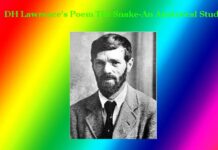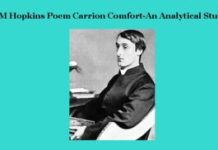The Poetic Technique of Emily Dickinson
The Poetic Technique (Style) of Emily Dickinson
The Poetic Technique of Emily Dickinson
‘Style’ refers to the characteristic manner or way of expression in prose or verse- it is how a speaker or writer represents whatever he says. The analysis and assessment of style involve the examination of the method, structure, device and diction of any literary art. The level of style should be appropriate to the speaker, occasion and dignity of a literary genre. Amongst the major poets of America, Miss Emily Dickinson is one who is a subject of much discussion as a queer poetess since her death till today and it is for her peculiar poetic style. She had written about two thousand poems in a style that seems strange, quaint and bold without having any precedent. Her style is full of originality and novelty which belongs to her and her alone. The ungrammatical and abundant use of capital letters, marked use of abundant dashes, the use of familiar terms, words and phrases in an unfamiliar way, the bold use of metaphor, use of both regular and irregular rhymes and prosody, strange imagery and the brevity of expression are the main characteristics of her poetic style.
The Use of Capital Letters
The first characteristic of her style which catches the attention of every reader is the use of capital letters. She uses capital letters ungrammatically and abundantly. She capitalizes sometimes nouns, sometimes pronouns, sometimes verbs, sometimes adverbs and what not! But what is the function of the use of abundant capital letters in her poetry? A scrutinized study shows that, perhaps, she used capital letters to her keywords to signify that they are worth emphasizing. For example, we can quote the following four lines:
‘Papa above!
Regard a Mouse
O’er powered by the cat!
Reserved within thy Kingdom.
A ‘Mansion’ for the Rat!’
Again we can take another poem entitled ‘I went to Heaven’ for instance. It is a poem consisting of only fifty words but it has eleven capitals, not counting sixteen capitals at the beginning of lines.
The Abundant Use of Dashes
The second outstanding trait of her style is the abundant use of dashes. She uses dashes at random without any grammatical rules. But her dashes signify more functions in addition to their general uses. Sometimes her dashes stand as ‘aposiopesis’ (aposiopesis is a figure of speech by which a writer or speaker suddenly breaks from what he is going to say and leaves the sentence incomplete as if unable or unwilling to continue) sometimes the dashes stand for commas, sometimes for colons, sometimes to indicate the pause of anticipation or suspense and sometimes for prosody or music. For example, we can take the poem, ‘These—Saw Vision—’:
‘These—Saw—Vision—
Latch them softly—
These—held Dimples—
Smooth them Slow—
This—addressed departing accents—
Quick—Sweet Mouth—to miss thee so—
This—We stroked—
Unnumbered satin—
These—we held among our own—
Fingers of the Slim Aurora—
Not so arrogant—this Noon—
This—adjust—that ran to meet us—
Pearl—for stocking—pearl for shoe—
Paradise—the only Place
Fit for Her reception—now—’
This is a poem of only fifteen lines, but in this poem, there are as many as twenty-eight dashes. It is the use of abundant dashes which differentiates her style much from that of others.
The Use of Familiar Words in Unfamiliar Ways
The third salient trait of Miss Dickinson’s poetic style is the use of familiar words and phrases in unfamiliar ways. She had a great genius of making phases like Shakespeare—the uses of unfamiliar or invented phrases show her to be so. She uses ‘purple territories’ for mountains; ‘the parlor of the day’ for noon’, ‘a narrow fellow in the grass’ for shake, ‘farther in the summer than the birds’ for cricket etc. But all these use of familiar phrases in unfamiliar ways enhances the beauty of her poetry.
The Use of Striking Metaphors
The fourth feature of her poetic style is the use of striking metaphors. She drew her metaphors—from Neo-Platonists, from the old and New Testaments of the Bible, from law and from science. She uses metaphors not merely for ornamentation or embellishment but for the sake of elucidation, clarification and amplification of meanings. For example, we can quote the following metaphors from her poetry, at random:
“I felt a Funeral in my Brain”— this metaphor is used to convey the intensity of mental pain.
“A clock stops”—it signifies the meaninglessness of human life on the earth.
“My life had Stood—a Loaded Gun”— through this metaphor the poetess conveys the passion of love which has excited much in her heart.
Thus her use of metaphor bears symbolic meanings which add to the beauty and charms to her poetry.
The Use of Both Regular and Irregular Rhyme and Prosody
The fifth characteristic of her poetic style is the use of both regular and irregular thymes and prosody sometime with coarse and quaint assonance. She follows no previous rules exactly and strictly. Besides the exact or eye-rhymes (as—come, home) she uses identical rhymes such as—stone, stone; vowel rhymes as—see, buy; imperfect rhymes as—time, thine; suspended rhymes as—thing, along. Such is the use of her prosody. But the assonance of her sentence and rhymes are not always musical and melodious—they are often callous and monotonous.
The Use of Strange Imageries: The sixth characteristic of her style is the use of familiar imagery with a strangeness that appeals to the grace of her thoughts. Her imageries are generally made up of metaphors. She is a wonder in creating imageries, as, like Shakespeare, she had the skill to tell a familiar thing in an unfamiliar way. Her nature imageries are especially noteworthy. For example, we can quote the following imagery which symbolizes humming bird—
‘A Route of Evanescence
With a revolving wheel—
A Resonance of Emerald—
A Rush of Cochineal—’
She gives a metaphorical description of the sunrise and sun-set in the following manner—
‘Blazing in gold and quenching in purple.’
The Brevity of Expression: The seventh but blazing and ever-present peculiarity of her style is the brevity of expression. She had a talent of saying and presenting her thought or feeling in the most simple, concise and economical manner. Her poems are short and even the contents of them are complete to a sense. Here is an example:
‘Pink—small—and punctual—
Aromatic—low
Convert—in April—
Candid—in May.’
Her brevity of expression corresponds to that of the telegraphic or short-hand use of language.
These are the poetic techniques of Miss Emily Dickinson and the above analysis shows that Emily Dickinson’s style was full of strangeness, quaintness and novelty. She began her poetic career with bold originality and practised it as much as she could. Had she published her poems during her lifetime she would have faced, certainly, adverse criticism and then she would have been compelled to refine and polish her style. Besides this, the use of illogical capital letters, dashes, and brevity of expression make her poetry a difficult one. And more it is to say that, it is less of her matter, but more of her style, she has been drawing the sympathy of her readers. 0 0 0
The Poetic Technique of Emily Dickinson
Read More: The Theme of Love in the Poetry of Emily Dickinson
N. B. This article entitled ‘The Poetic Technique (Style) of Emily Dickinson’ originally belongs to the book ‘Emily Dickinson’s Poetry: A Thematic Study‘ by Menonim Menonimus. The Poetic Technique of Emily Dickinson
Books of Literary Criticism by M. Menonimus:
- World Short Story Criticism
- World Poetry Criticism
- World Drama Criticism
- World Novel Criticism
- World Essay Criticism
- Indian English Poetry Criticism
- Indian English Poets and Poetry Chief Features
- Emily Dickinson’s Poetry-A Thematic Study
- Walt Whitman’s Poetry-A Thematic Study
- Critical Essays on English Poetry
- Tawfiq al-Hakim’s Novel: Return of the Spirit-An Analytical Study
- Tawfiq al-Hakim’s Novel: ‘Yawmiyyat Naib Fil Arayaf’-An Analytical Study
- Analytical Studies of Some Arabic Short Stories
- A Brief History of Arabic Literature: Pre-Islamic Period …
Related Searches:
- Art and Technique of Emily Dickinson’s Poetry
- Pain as a Theme in Emily Dickinson’s Poetry
- Emily Dickinson as a Poet of Nature
- Theme of Death in the Poetry of Emily Dickinson
- Concept of Death in the Poetry of Emily Dickinson
- Mysticism of Emily Dickinson
- Mysticism in the Poetry of Emily Dickinson
- Emily Dickinson Biography
- Emily Dickinson-Poetry Foundation
- Emily Dickinson’s Collected Poems Themes
- Major Themes of Emily Dickinson’s Poetry
- Emily Dickinson: Poems and Poetry Analysis











